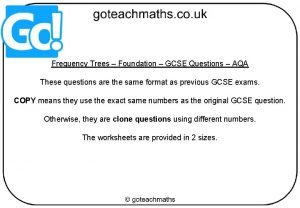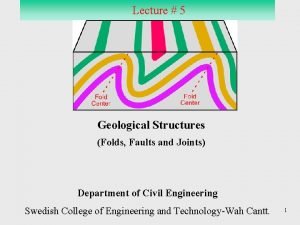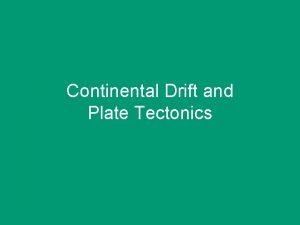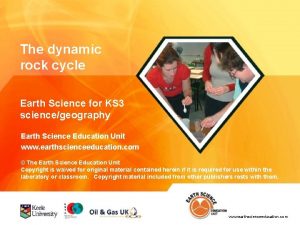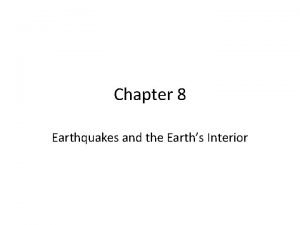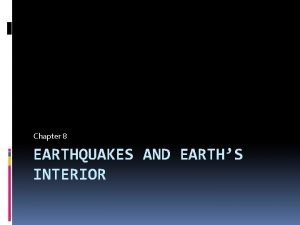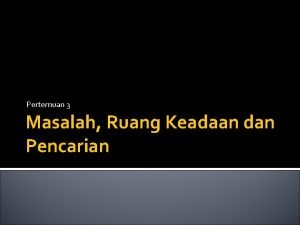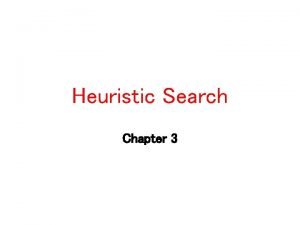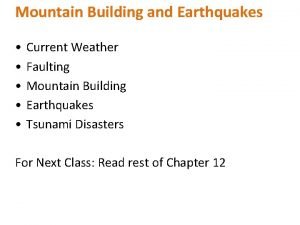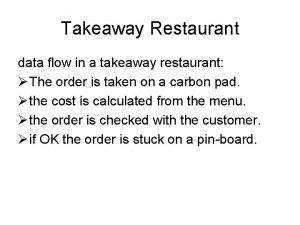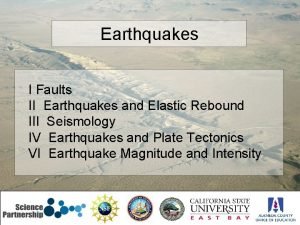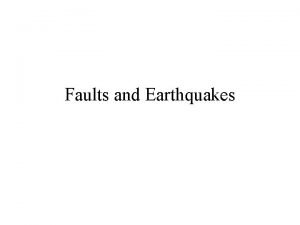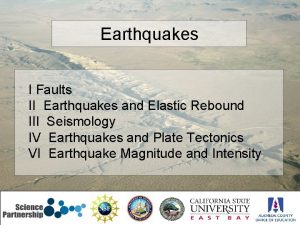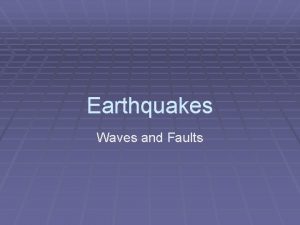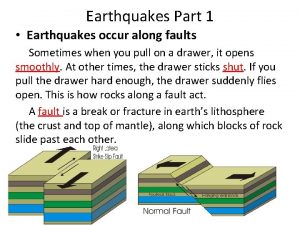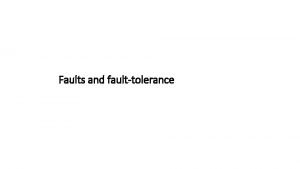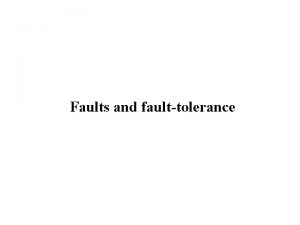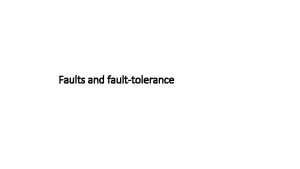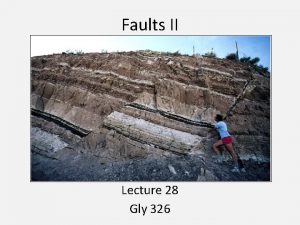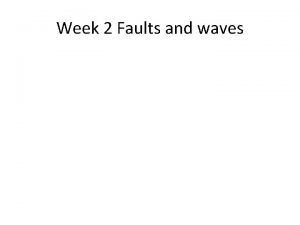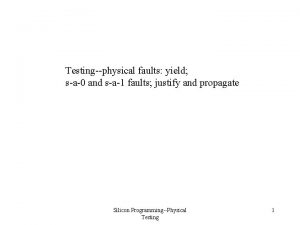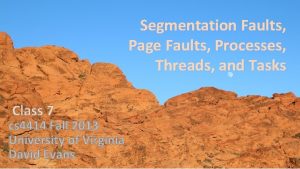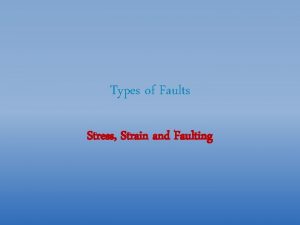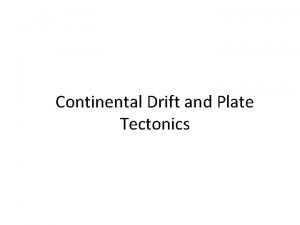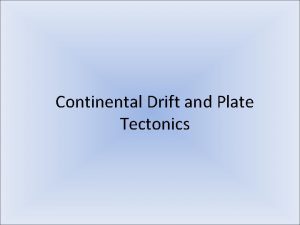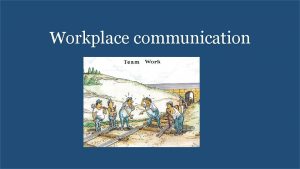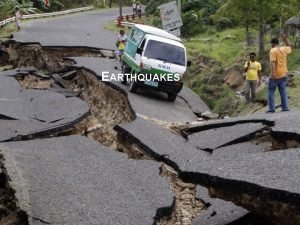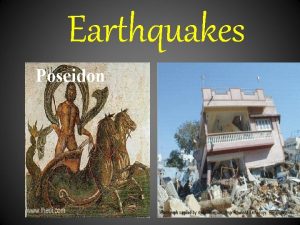Faults and Earthquakes TakeAway Points 1 Earthquakes generate























- Slides: 23

Faults and Earthquakes

Take-Away Points 1. Earthquakes generate waves that travel through the earth 2. Earthquakes occur when rocks slip along faults 3. Faults are classified by the kinds of movement that occur along them 4. Earthquakes don’t kill people, collapsing buildings and flooding kill people 5. Magnitude and Intensity 6. Seismic waves are used to map the earth’s interior 7. Predicting earthquakes is not yet possible

What is the Elastic Rebound Theory? • Explains how energy is stored in rocks – Rocks bend until the strength of the rock is exceeded – Rupture occurs and the rocks quickly rebound to an undeformed shape – Energy is released in waves that radiate outward from the fault

The Focus and Epicenter of an Earthquake • The point within Earth where faulting begins is the focus, or hypocenter • The point directly above the focus on the surface is the epicenter

Some Important Earthquakes 1906 - San Francisco • Killed 500 (later studies, possibly 2, 500) • First Revealed Importance of Faults 1923 – Tokyo - Killed 140, 000 in firestorm 1964 - Alaska • Killed about 200 • Wrecked Anchorage. • Tsunamis on West Coast. 1976 - Tangshan, China • Hit an Urban Area of Ten Million People • Killed 650, 000

How Seismographs Work 1. Earthquakes generate waves that travel through the earth

Seismic Waves 1. Earthquakes generate waves that travel through the earth

Body Waves: P and S waves • Body waves – P or primary waves • fastest waves • travel through solids, liquids, or gases • compressional wave, material movement is in the same direction as wave movement – S or secondary waves • slower than P waves • travel through solids only • shear waves - move material perpendicular to wave movement

Surface Waves: R and L waves • Surface Waves – Travel just below or along the ground’s surface – Slower than body waves; rolling and side-to-side movement – Especially damaging to buildings

Elastic Rebound 2. Earthquakes occur when rocks slip along faults

How is an Earthquake’s Epicenter Located? Seismic wave behavior – P waves arrive first, then S waves, then L and R – Average speeds for all these waves is known – After an earthquake, the difference in arrival times at a seismograph station can be used to calculate the distance from the seismograph to the epicenter.

How is an Earthquake’s Epicenter Located? Time-distance graph showing the average travel times for P- and Swaves. The farther away a seismograph is from the focus of an earthquake, the longer the interval between the arrivals of the P- and Swaves

How is an Earthquake’s Epicenter Located? • Three seismograph stations are needed to locate the epicenter of an earthquake • A circle where the radius equals the distance to the epicenter is drawn • The intersection of the circles locates the epicenter

Where Do Earthquakes Occur and How Often? ~80% of all earthquakes occur in the circum-Pacific belt – most of these result from convergent margin activity – ~15% occur in the Mediterranean-Asiatic belt – remaining 5% occur in the interiors of plates and on spreading ridge centers – more than 150, 000 quakes strong enough to be felt are recorded each year

Major Hazards of Earthquakes • • Building Collapse Landslides Fire Tsunamis (Not Tidal Waves!) 4. Earthquakes don’t kill people, buildings kill people

Safest & Most Dangerous Buildings • • • Small, Wood-frame House - Safest Steel-Frame Reinforced Concrete Unreinforced Masonry Adobe - Most Dangerous 4. Earthquakes don’t kill people, buildings kill people

Tsunamis Probably Caused by Submarine Landslides Travel about 400 M. p. h. Pass Unnoticed at Sea, Cause Damage on Shore Warning Network Around Pacific Can Forecast Arrival Whether or Not Damage Occurs Depends on: • Direction of Travel • Harbor Shape • Bottom • Tide & Weather 4. Earthquakes don’t kill people, buildings kill people

Magnitude and Intensity • How Strong Earthquake Feels to Observer Magnitude • Related to Energy Release • Determined from Seismic Records • Rough correlation between the two for shallow earthquakes 5. Magnitude and Intensity

Intensity How Strong Earthquake Feels to Observer Depends On: • Distance to Quake • Geology • Type of Building • Observer! 5. Magnitude and Intensity

Magnitude - Determined from Seismic Records Richter Scale: • Related to Energy Release • Exponential • No Upper or Lower Bounds • Largest Quakes about Mag. 8. 7 • Magnitude-Energy Relation – – – 4 -1 5 - 30 6 - 900: 1 Megaton = about 7 7 - 27, 000 8 - 810, 000 5. Magnitude and Intensity

Magnitude and Energy Magnitude Energy Explosive Power Example 9 U. S. Energy Use for a month Alaska 1964 Indonesia 2004 8 U. S. Energy Use for a day San Francisco, 1906 7 6 5 One Megaton World Series Earthquake, 1989 U. S. Energy Use for Large Thunderstorm a minute One Kiloton 4 3 One ton of explosives 5. Magnitude and Intensity World Trade Center Collapse

Magnitude and Energy Magnitude Energy 3 Explosive Power Example One ton of Explosives World Trade Center Collapse 2 1 Topple 50 -meter tree One kilogram of explosives Head-on colision at 60 mph 0 Drop a car 10 meters Half stick of dynamite Very bad day skydiving -1 Impact of bullet One gram of explosives -2 Hammer blow -3 Dribbling a basketball 5. Magnitude and Intensity

Take-Away Points 1. Earthquakes generate waves that travel through the earth 2. Earthquakes occur when rocks slip along faults 3. Faults are classified by the kinds of movement that occur along them 4. Earthquakes don’t kill people, buildings kill people 5. Magnitude and Intensity 6. Seismic waves are used to map the earth’s interior 7. Predicting earthquakes is not yet possible
 A takeaway sells 10 inch pizzas and 12 inch pizzas
A takeaway sells 10 inch pizzas and 12 inch pizzas A takeaway sells 10 inch pizzas
A takeaway sells 10 inch pizzas Mathedup takeaway
Mathedup takeaway Brand positioning bullseye
Brand positioning bullseye Points of parity and points of difference
Points of parity and points of difference Generate and develop artistic ideas
Generate and develop artistic ideas Faults and folds
Faults and folds Normal reverse and transform faults
Normal reverse and transform faults Make your own folds and faults answer key
Make your own folds and faults answer key How to overcome little foxes
How to overcome little foxes Chapter 8 section 2 earthquake measurement answer key
Chapter 8 section 2 earthquake measurement answer key Chapter 8 earthquakes and volcanoes
Chapter 8 earthquakes and volcanoes Chapter 8 earthquakes and earth's interior
Chapter 8 earthquakes and earth's interior Chapter 8 earthquakes and earth's interior answer key
Chapter 8 earthquakes and earth's interior answer key Masalah ruang keadaan dan pencarian
Masalah ruang keadaan dan pencarian Contoh generate and test
Contoh generate and test Generate and test heuristic search
Generate and test heuristic search At the most fundamental level firms generate cash and
At the most fundamental level firms generate cash and Sentence faults
Sentence faults Classimat faults chart
Classimat faults chart What is the flour to fat ratio for short pastry?
What is the flour to fat ratio for short pastry? Gia-12-1
Gia-12-1 Army 5988 example
Army 5988 example Reverse fault
Reverse fault
